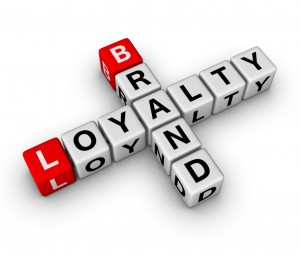What percent of the time do your loyal buyers actually buy your brand?
The data might surprise you. Catalina analyzes tens of millions of shopper purchase patterns to determine what coupons should be dispensed to a given shopper ID at checkout. The data they shared with me two years ago on laundry detergent and bottled water showed that the brand bought most often by a given shopper is still only bought about 2/3rds of the time. In other words, a third of the time, shoppers are buying a LESS PREFERRED brand! Worse, these loyal customers aren’t automatically retained. My own published brand equity paper in JAR shows that, of those who are loyal to a brand in a given year (50% plus share of requirements), only half are still loyal to the same brand one year later.
From modeling loyalty distributions for many years from household purchase panel data, I have estimated that only 15% of brand buyers can be considered truly loyal and engaged with a typical CPG brand that they ever buy.
This amount of purchasing switching and churn is not surprising to me. But I wonder if marketers and ad agency execs generally realize how much customer sharing, conquest, and churn there is. I don’t think they do.
If I’m right, the second point in this blog is to understand why marketers form hardened incorrect beliefs misdirecting brand growth strategies. For this answer, I turn to some of the principles in Nobel Prize winner Daniel Kahneman’s best seller, “Thinking, Fast and Slow”.
The behavioral economist notes that telling stories is easy for humans, while doing math is hard. We have a bias towards creating and believing stories that give a cohesive explanation. We create strong narratives for past examples that provide retrospective certainty but have little predictive value. He notes that consultants’ books do this regularly, like Jim Collin’s Good to Great. (One “stellar company” was Circuit City…hmmm…maybe he should have called the book “Good to Gone”.) The feeling of certainty is so euphoric we seek this out.
I think the culprit is the power of persuasive stories as told by marketing gurus. Social media zealots will point to the success of Old Spice. The cautious observer will note that if we had more success stories like that, indicating we knew how to engineer success and virality, we would not be mentioning Old Spice at every conference. Branding gurus use great stories to preach that brands are expressions of self-narrative where consumers find the brand to which they will form deep attachment with no regard to actual purchasing data or the constant threat of private label.
Take the following narrative about Starbucks vs. Dunkin Donuts loyal customers from an anthropologist’s study reported on in the Wall Street Journal on April 2006.
Dunkin’ Donuts last year paid dozens of faithful customers in Phoenix, Chicago and Charlotte, N.C., $100 a week to buy coffee at Starbucks instead. At the same time, the no-frills coffee chain paid Starbucks customers to make the opposite switch.
When it later debriefed the two groups, Dunkin’ says it found them so polarized that company researchers dubbed them “tribes” — each of whom loathed the very things that made the other tribe loyal to their coffee shop. Dunkin’ fans viewed Starbucks as pretentious and trendy, while Starbucks loyalists saw Dunkin’ as austere and unoriginal.
“I don’t get it,” one Dunkin’ regular told researchers after visiting Starbucks. “If I want to sit on a couch, I stay at home.”
So from n = “dozens”, we are led to believe that no one goes to both chains, I wonder what would actual quantification show about customer sharing? We need to create stories that deliver correct assessments from hard data in unforgettable ways, not imagine hard data from the interpretive stories consultants construct to explain individual marketing cases with false certainty.
For 85% of consumer/brand relationships, the data suggest that brands function as simplifying heuristics, in the way that behavioral economists might use the phrase. They help shoppers get through a big shopping trip in half an hour rather than two hours. This is not to denigrate the value of branding, as the recognition, trust, perceived fit to purpose, and familiarity that someone has towards a brand is a tremendous asset but it does not produce exclusive brand buying patterns.
Final words of advice by Daniel Kahneman in “Thinking, Fast and Slow”: when faced with an important choice, he advises us to slow down our decision processes and force ourselves to use “System 2” (rational, calculating). I think these are wise words for marketing teams. Get grounded and prove your beliefs before making them the basis of decision-making.


Joel:
I do think this is a matter of degree. 2/3’s loyalty is a pretty high number. Andrew Ehrenhardt’s work did show that big brands were big both because of deeper penetration and deeper loyalty. Others have shown that a small cohort of loyalists is often the brand advocates who spread positive word of mouth (Keller/Fay).
Be that as it may I agree we should always avoid generalizations. 🙂
And “Thinking, Fast and Slow” is a good book!
Bruce
Hmmmm no Bruce, absolutely not – Andrew EhrenBERG showed that big brands are big mainly because they have more buyers, with only a small part due to slightly higher loyalty (double jeopardy). Joel – this work has all been done by Ehrenberg and the findings you have seen are entirely consistent with what is almost always observed from this type of data.